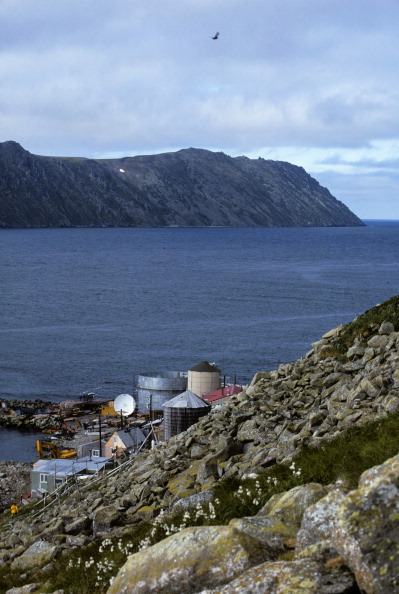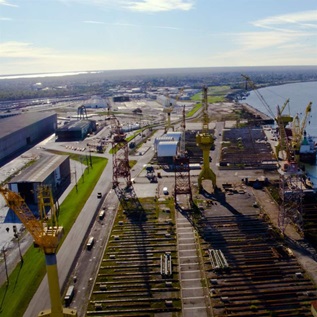Arctic Shipping Rules Needed to Protect Alaska Region
More vessels are crossing the Arctic than ever before. Traffic through one passage, the Northern Sea Route in Russia, increased from just two vessels in 2009 to 71 vessels in 2013. Experts forecast that the volume of cargo coming through that route is likely to increase from 1.36 million tons in 2013 to 4 million tons this year and 65 million tons by 2020. But despite some recent progress, ships are not yet required to follow strong safety and environmental standards in the Arctic.
Yes, the movement of ships, crews, and cargo through the area brings economic opportunity, but it also exposes people and the environment to potential harm.
As cargo ships come across northern Russia and through the Bering Strait, few government or private resources are available within the region to respond in case of distress. Vessels generate air and water pollution as well as noise, which can alter marine mammals’ behavioral and migratory patterns. Boats can collide with whales and other marine mammals and can also interfere with the subsistence activities and the safety of indigenous people in small boats who regularly use the waterway. Even village life on shore can be affected when cruise ships, just beginning to ply the waters here, sometimes arrive unannounced and discharge passengers to wander the streets.
 © Wolfgang Kaehler
© Wolfgang KaehlerThe Inupiat community on Little Diomede, a U.S. island in the middle of the 44-mile-wide Bering Strait, is one of many villages affected by increasing ship traffic. Clear and consistent rules will help protect people and wildlife in the U.S. Arctic.
Recent leadership in the United States and abroad offers hope. The International Maritime Organization in May adopted the Polar Code, which strengthens the standards for ships operating in Arctic and Antarctic waters. When the code goes into effect in 2017, ships traveling in the Arctic will have to meet certain ice classifications and have on board specially trained ice navigators. The measures also include limits on how much oil, noxious materials, sewage, and trash a vessel may dump at sea.
That’s a good start, but we need even stronger standards of care to adequately protect the region. Dumping from ships should be restricted not only when sea ice is present but also during the open water season. Heavy fuel oil, thicker and dirtier than lighter grades, is used for power on some vessels and as cargo on others. Because it can persist in the environment and is difficult to remove from the water, its use in Arctic shipping should be banned.
There are also opportunities to develop strong “rules of the road” for U.S.-regulated vessels traveling in this sensitive region. The Coast Guard has initiated a Port Access Route Study to consider vessel traffic routing measures to reduce the chance of accidents in the Bering Strait. These could include establishment of shipping lanes that result in more predictable travel patterns, which would boost safety and efficiency for both large ships and smaller local boats. The Coast Guard should also consider designating “areas to be avoided”—places where ships should not go because of navigation hazards such as shallows, or where local subsistence areas or ecologically valuable areas need to be protected.
Such measures would be important steps toward sound governance of a narrow strait that poses risks to mariners and is home to active subsistence communities, large bird colonies, and marine mammals.
Mariners coming into this rapidly changing region need the best available information, including real-time weather forecasts, updated and accurate nautical charts, and e-navigation resources such as enhanced automatic identification system (AIS) for tracking vessels.
Enhanced AIS, as part of a vessel safety communication system, can further increase what’s called maritime domain awareness—the understanding of security, safety, economic, or environmental matters—for the Coast Guard and other agencies responsible for national security, disaster response, and environmental stewardship. It can also help improve communication with Bering Strait communities, and it probably would lessen chances of large ships crossing paths with small hunting skiffs.
Even with the best prevention, accidents can happen. That’s why coastal Arctic communities need to be prepared with adequate resources and training to respond to a variety of emergencies, including search-and-rescue operations and oil spill response. The Alaskan Arctic: A Summit on Shipping and Ports, a gathering this week in Anchorage, is an ideal opportunity for government, community, and business leaders to discuss investing in and building the necessary marine infrastructure for safe and reliable shipping.
A natural part of increased vessel traffic in the Arctic is the design and construction of ports. But even as that happens a number of best practices should be put in place to reduce threats. The Polar Code and related IMO rules should be further developed to keep unsafe vessels out of Arctic waters and ensure that vessels coming through do so with minimal impact on the environment and the people of the region. The ideas suggested in the Port Access Route Study process should be put into place and expanded to address cultural and environmental protection in addition to maritime safety.
Clear and consistent rules that enhance maritime safety and best preserve what is important to Alaskans will benefit the entire Arctic region, now and far into the future.
This article was originally published in the Alaska Dispatch.
Henry P. Huntington directs the science work for The Pew Charitable Trusts’ Arctic programs. He is also an independent researcher who contributed to the Arctic Council’s Arctic Marine Shipping Assessment and has published widely on Arctic matters. He lives in Eagle River.











